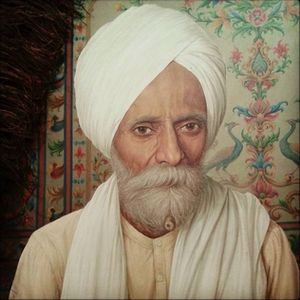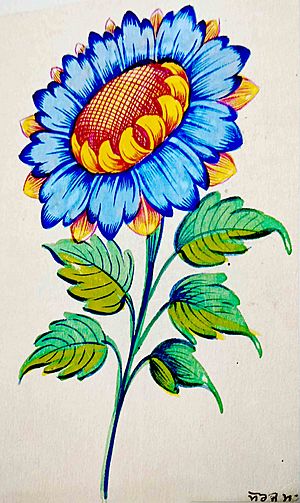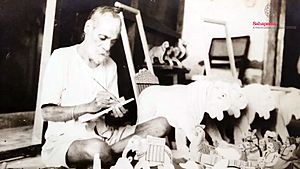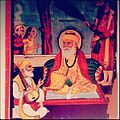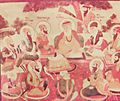Gian Singh Naqqash facts for kids
Gian Singh Naqqash (1883 – 1953) was a talented Punjabi Sikh artist. He was famous for painting beautiful frescoes, which are paintings done on wet plaster. He worked at the famous Golden Temple for over 33 years. Gian Singh is especially known for his unique style, which is part of what is called the Sikh School of Painting.
Contents
Life of a Sikh Artist
Early Years
Gian Singh was born in 1883 in Amritsar, a city in Punjab. His family did not have a background in art. His father, Charan Singh, made combs. As a child, Gian Singh studied with Giani Thakur Singh, a Sikh teacher.
After finishing primary school, he became an apprentice to Nihal Singh Naqqash. An apprentice is someone who learns a skill from a master. Nihal Singh was a skilled artist whose family had worked for Maharaja Ranjit Singh, a famous Sikh ruler. Gian Singh learned drawing and painting from Nihal Singh for 14 years.
When Nihal Singh passed away in 1905, Gian Singh continued his studies. He learned from Nihal Singh's brother, Jawahar Singh, who also worked at the Golden Temple. Jawahar Singh taught him different painting styles, including the Kangra school of miniature painting.
Working at the Golden Temple
Gian Singh mainly painted murals at the Golden Temple complex in Amritsar. He was the official "Naqqash" (artist) for the temple from about 1899 to 1931. He was influenced by the Akali movement, which was a Sikh religious and political movement. Because of this, he often included Sikh symbols like the khanda and kirpans in his murals.
He liked to use a deep, grayish-blue color called surmai instead of black. He said this helped his paintings feel more real. Many of his murals inside the Golden Temple are near the Har ki Pauri area. Over the years, some of his wall paintings have been refreshed by other artists. It was Gian Singh's idea to decorate the arches of the windows in the temple with paintings.
Gian Singh created new designs on the inner walls, ceilings, and window arches of the first floor. He painted local flowers in beautiful patterns called dehin. These patterns were part of a fresco style called mohrakashi. He would arrange flowers, leaves, and vines with grapevines or fancy floral patterns in corners, squares, and rectangles. He paid close attention to every detail, even a single petal. These flowers represented different seasons and ragas (traditional Indian music modes).
He also painted small pictures of actual gurdwara buildings within his frescoes. Another new idea he brought was adding Gurmukhi calligraphy from Sikh scriptures like Sukhmani Sahib and Japji Sahib to the window arches. Gian Singh was also skilled in pietra dura, which is a type of stone inlay artwork. He used this skill in various gurdwaras.
His unique style included making nature look three-dimensional. For example, he would add details to leaves to make them pop out. For bird designs, he would even paint tiny hairs to make them look very real. Gian Singh believed that making his art more realistic would bring viewers closer to God.
Art Techniques and Spirituality
Gian Singh used traditional methods to make his paints. He used natural ingredients and made his own brushes. He would grind and burn pigments himself to get the colors he needed. He would burn stones with cow-dung overnight to create a powder for his murals. The colors came from natural sources like leaves, stems, and seeds.
Painting was a very spiritual activity for Gian Singh. He would often recite the name of God, Waheguru, while he painted. He also listened to Gurbani kirtan (Sikh hymns) while working in the Golden Temple. Before starting a new mural, he would ask for blessings and honor his teachers, Nihal Singh and Jawahar Singh.
Unlike earlier Sikh artists who sometimes painted Hindu gods, Gian Singh focused on animals like birds, flowers, and vines. He took inspiration from the natural world around him.
Besides murals, he also worked with gach (stuccowork), jarathari (mosaic work), and tukri (cut-glass work). He was skilled not only in the Sikh art style but also in the Kangra, Pahari, and Mughal schools of painting.
Later Life and Family
Gian Singh was also a writer. He wrote many books in Punjabi, Hindi, or Urdu about traditional art and crafts. These books were published in Amritsar.
After he retired from being the official artist of the Golden Temple, he started framing pictures and taking photographs.
Gian Singh had three sons. His oldest son, Sunder Singh, passed away at age 17 during the Jallianwala Bagh massacre in 1919. His middle son, Jagat Singh, became an expert in ayurveda (traditional Indian medicine). His youngest son, G.S. Sohan Singh, followed in his father's footsteps and became a painter. Sohan Singh started by painting with oil on canvas, even though he learned traditional Sikh art methods.
In his final years, Gian Singh faced financial difficulties. He painted clay and wooden toys to sell and earn money. He also painted banners for theaters. He even traveled to Pakistan to learn about block printing. He made block prints of religious paintings to sell for food. He was skilled in making different types of printing blocks for religious themes. He also tried watercolor paintings, oil paintings, calendar designs, and newspaper advertisements. He even took photographs of the Golden Temple.
Gian Singh had many friends who were also painters, including Sobha Singh and Mulk Raj Anand. These famous people respected Gian Singh very much.
Gian Singh was a mentor to his son, Sohan Singh, and trained him. He also taught his grandsons, like Surinder Singh, how to grind pigments and draw.
Gian Singh passed away in 1953 at the age of 70. He was still struggling financially at that time.
Gian Singh's Legacy
Gian Singh was worried that his artwork might be damaged by future renovations at Sikh heritage sites. Sadly, much of his work has been lost or changed over the years.
His detailed instructions on how to create a mural in the traditional Sikh style can be found in his book, Naqqashi Darpan. His grandson, Surinder Singh, later translated and explained this important work. Many of Gian Singh's artworks have been published in Sikh and Punjabi magazines.
His family is now planning to create a digital collection of his artwork. They hope this will help bring back interest in the traditional Sikh school of art. Experts continue to study his artwork.
"He (Bhai Gian Singh Naqqash) focused all his attention and worked very hard like doing meditation and wonderful naqqashi created by him with his art are like attaining spiritual enlightenment."
Books by or About Gian Singh
Other Works
- Gian Chitravali: Masterpieces of the Late Bhai Gian Singh Naqqash (written by G.S. Sohan Singh) - 1956
Honours
- Siropa - Shiromani Gurdwara Parbandhak Committee (1949)
Gallery
Mural (Naqqashi)
Miniatures


